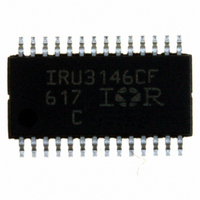IRU3146CFTR International Rectifier, IRU3146CFTR Datasheet - Page 12

IRU3146CFTR
Manufacturer Part Number
IRU3146CFTR
Description
IC PWM DUAL SYNC 28-TSSOP
Manufacturer
International Rectifier
Specifications of IRU3146CFTR
Pwm Type
Voltage Mode
Number Of Outputs
2
Frequency - Max
345kHz
Duty Cycle
85%
Voltage - Supply
4.5 V ~ 16 V
Buck
Yes
Boost
No
Flyback
No
Inverting
No
Doubler
No
Divider
No
Cuk
No
Isolated
No
Operating Temperature
0°C ~ 70°C
Package / Case
28-TSSOP
Frequency-max
345kHz
Lead Free Status / RoHS Status
Contains lead / RoHS non-compliant
IRU3146
The gate drive requirement is almost the same for both
MOSFETs. Logic-level transistor can be used and cau-
tion should be taken with devices at very low V
vent undesired turn-on of the complementary MOSFET,
which results a in shoot-through.
The total power dissipation for MOSFETs includes con-
duction and switching losses. For the Buck converter,
the average inductor current is equal to the DC
load current. The conduction loss is defined as:
The R
ered for the worst case operation. This is typically given
in the MOSFET data sheet. Ensure that the conduction
losses and switching losses do not exceed the package
ratings or violate the overall thermal budget.
Choose IRF7457 both for control and synchronous
MOSFET. This device provide low on-resistance in a com-
pact SOIC 8-Pin package.
The MOSFET have the following data:
The total conduction losses for each output will be:
The switching loss is more difficult to calculate, even
though the switching transition is well understood. The
reason is the effect of the parasitic components and
switching times during the switching procedures such
as turn-on / turnoff delays and rise and fall times. The
control MOSFET contributes to the majority of the switch-
ing losses in a synchronous Buck converter. The syn-
chronous MOSFET turns on under zero voltage condi-
tions, therefore, the switching losses for synchronous
MOSFET can be neglected. With a linear approxima-
tion, the total switching loss can be expressed as:
12
P
P
P
P
P
P
ϑ = R
IRF7457
V
I
R
D
CON(TOTAL, 1.8V)
CON(TOTAL, 1.8V)
CON(TOTAL, 2.5V)
CON(TOTAL, 2.5V)
COND
COND
DSS
DS(ON)
= 15A
DS(ON)
= 20V
DS(ON)
(Upper Switch) = I
(Lower Switch) = I
= 7mΩ
temperature dependency should be consid-
Temperature Dependency
= 1.0W
= P
= 1.0W
= P
CON(UPPER)
CON(UPPER)
LOAD
LOAD
2
2
+ P
+ P
×R
×R
CON(LOWER)
CON(LOWER)
DS(ON)
DS(ON)
×D×ϑ
×(1 - D)×ϑ
GS
to pre-
www.irf.com
These values are taken under a certain condition test.
For more details please refer to the IRF7457 data sheet.
By using equation (9), we can calculate the total switch-
ing losses.
P
P
Programming the Over-Current Limit
The over-current threshold can be set by connecting a
resistor (R
OCSet pin. The resistor can be calculated by using equa-
tion (3).
The R
should be considered for the worse case operation.
R
I
(50% over nominal output current)
This results to:
R
P
Where:
V
t
t
T = Switching Period
I
SET
From IRF7457 data sheet we obtain:
LOAD
r
f
IRF7457
t
t
SW(TOTAL,2.5V)
SW(TOTAL,1.8V)
DS(ON)
SET
SW
DS(OFF)
r
f
= Rise Time
= Fall Time
= 7ns
= 16ns
≅ I
=
= R
= Load Current
DS(ON)
Figure 13 - Switching time waveforms.
O(LIM)
90%
10%
= 7mΩ×1.5 = 10.5mΩ
V
V
V
= Drain to Source Voltage at off time
1
DS(OFF)
GS
=R
DS
2
SET
= 10A×1.5 = 15A
has a positive temperature coefficient and it
t
d
6
= 0.414W
= 0.414W
(ON)
=7.8KΩ
) from drain of low side MOSFET to the
×
t
r
+
T
t
f
t
×
r
I
LOAD
t
d
(OFF)
---(9)
t
f
Rev. 1.1
6/25/04






